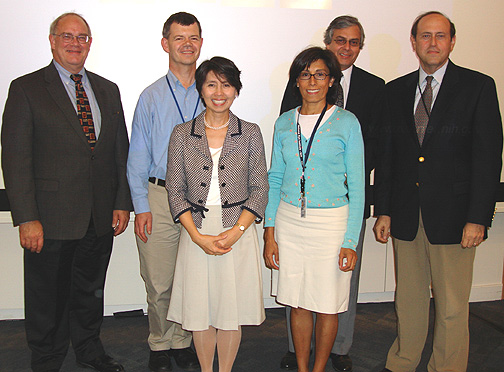
| T H E N I H C A T A L Y S T | N O V E M B E R – D E C E M B E R 2007 |
|
|
|
Research
Festival
|
by Fran Pollner |
 |
|||
|
The
eyes have it: (NEI colleagues, left to right) Paul Sieving, symposium
co-chair Michael Redmond, Emily Chew, co-chair Patricia Becerra, Juan
Amaral, and Robe
|
Three spotlights have converged on the eye over the past 20 years, illuminating the genetic underpinnings of eye disease, the immunological environment of the eye, and the environmental modifiers of inborn propensities to eye disorders.
Following these pathways leads to formidable strategies to combat retinal neurodegeneration and choroidal neovascularization, the major instruments of blindness, panelists agreed at a Research Festival symposium focused on recent advances in eye research. The panelists, all NEI investigators, were themselves instruments of many of these advances.
RPE65
In the early 1990s, the lab of Michael Redmond identified and cloned the RPE65 gene. Since that time, researchers have found more than 60 mutations in its 14 exons, all causing eye disease ranging from early-onset severe disease to milder late-onset phenotypes. Half were missense mutations. The team looked for mutations in patients with Leber congenital amaurosis (LCA) and childhood-onset severe retinal dystrophy—two of the earliest blinding conditions—and found them, recalled Redmond, chief of the Molecular Mechanisms Section in the Laboratory of Retinal Cell and Molecular Biology (LRCMB).
The lab developed an expression system and proved that RPE65 is required for the production of 11-cis retinal, essential for vision. They generated Rpe65-knockout mice that could not produce 11-cis retinal and lacked rhodopsin.
The lab has also been involved in gene therapy studies involving dog LCA models, in which functional recovery of the treated eye has been demonstrated on electroretinogram. Four early-phase clinical trials are currently underway in the United States and abroad, Redmond noted.
CNTF
As of a year ago, said NEI Director Paul Sieving, 117 genes contributing to the death of photoreceptor cells had been cloned. Animal work with neurotrophic protective factors has shown that such lost vision is salvageable.
A neurotrophic protective factor with demonstrated photoreceptor-rescue ability in 13 different rat and mouse mutants with retinal degeneration was put to the test in 10 retinitis pigmentosa patients in a Phase I NEI study. Not only was safety shown, but potential efficacy was promising enough to warrant a move to Phase II, said Sieving, the study PI.
The agent—ciliary neurotrophic factor (CNTF)—was encapsulated within a semipermeable intravitreal implant. The implant was removed after six months, but retinal cells continued to secrete CNTF, possibly as a result of persisting vitreous nourishment, Sieving remarked.
The CNTF-implanted eye showed a trend to higher acuity, with several of the patients demonstrating a three- to four-line improvement in reading the eye chart in the treated eye. "The patients’ enthusiasm was gratifying; they wanted implants in their other eye as well," Sieving said.
PEDF
Pigment epithelium–derived factor (PEDF) is another agent that has passed Phase I human safety tests. "It is neurotrophic, antitumorigenic, antiangio-genic, and anti-inflammatory—it is a very versatile protein," said Juan Amaral, a staff scientist in Patricia Becerra’s Section of Protein Structure and Function, LRCMB. PEDF was also cloned in the early 1990s in the LRCMB and has been studied extensively in this lab.
Using rat models, Amaral and Becerra have been exploring the potential for therapeutic delivery of this protein. "We propose subconjunctival delivery, either by injection or, simpler and safer, a sustained delivery device," he said, noting that the team has documented rapid diffusion to relevant areas, with intense scleral, choroidal, and retinal signals.
Subconjunctival injections of PEDF proteins can inhibit progression and induce regression of laser-induced neovessels in the choroid of rats, Amaral said.
Immune Mediation
The mechanisms underlying atherosclerosis also underlie choroidal neovascularization and age-related macular degeneration (AMD)—they are all inflammatory, immune-mediated conditions, suggested Robert Nussenblatt, head of the Laboratory of Immunology.
The therapeutic implications of this perspective are now being investigated in an NEI clinical trial of the anti-inflammatory agents inflixamab, sirolimus, and dacluzimab to treat choroidal subretinal neovascularization in patients with AMD, said Nussenblatt, the trial PI. He noted that restoration of the downregulatory immune environment of the eye is the hoped-for therapeutic mechanism.
"But while this is a great idea," he added, "we don’t know that these medications will achieve that goal. Rather, we are treating the result of the immune dysregulation."
AREDS and AREDS2
Whatever the genetic and immune components of AMD, the ability of a regimen of antioxidants, copper, and zinc to stem progression in patients with moderate AMD speaks loudly to the role of nutrition in warding off an otherwise relentless disease course, observed Emily Chew, deputy director of the Division of Epidemiology and Clinical Research and chief of the Clinical Trials Branch.
The trial regimen in the NEI-sponsored Age-Related Eye Disease Study (AREDS), which involved nearly 5,000 patients, yielded a 25 percent reduction in progression to advanced AMD. The regimen has become a standard nutritional supplement for patients with AMD and, if taken by all at-risk individuals, could be expected to prevent progression in about 300,000.
AREDS2 is
currently recruiting 4,000 people into a five-year study of the effects on AMD
of w-3 long-chain polyunsaturated fatty acids and
the antioxidant carotenoids lutein and zeaxanthin. Chew noted that lutein is
now viewed as a substitute for b-carotene, shown
in two NCI-supported lung cancer trials to increase lung cancer and mortality
risk among smokers. ![]()